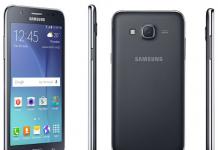Specifications
- Android 6.0.1
- Screen 5 inches, 720x1080 pixels (294 ppi), PLS TFT, Corning Gorilla Glass 4, with 2.5D effect
- 2 GB of RAM, 16 GB of internal memory (10.7 GB available to the user), microSD memory cards up to 256 GB
- Quad-core Exynos 7570 processor, frequency up to 1.4 GHz, Mali T720 graphics coprocessor
- Li-Pol battery, 2400 mAh, video playback up to 12 hours, in 3G or LTE - up to 14 hours, talk time - up to 16 hours
- Front camera 5 megapixels (f/2.2), main camera 13 megapixels (f/1.9)
- FM radio
- Fingerprint sensor
- Two nanoSIM cards, two separate trays, independent of microSD
- USB 2.0, BT 4.1, 802.11 b/g/n, GPS/GLONASS
- Case colors gold/black
- Fingerprint scanner
- Sensors – accelerometer, proximity sensor
- SAR value for Europe 0.448 W/kg (head), 1.25 W/kg (body)
- Dimensions – 142.8x69.5x8.1 mm, weight – 143 grams
Contents of delivery
- Telephone
- Charger
- SIM tray eject tool
- Wired stereo headset
- Instructions
Positioning
The J line has always been a budget solution; it came under the A-series from Samsung. In order to highlight the models that are simplified versions of the A-series, the Prime prefix was added to them, that is, the J5 Prime is a simplified version of the older device. Simplification means removing the SuperAMOLED screen and replacing it with a TFT screen typical in this price segment, although it has a PLS TFT matrix, which is very good for this price group. Of course, other characteristics were also slightly reduced - screen resolution, battery capacity, and support for dual-band Wi-Fi was removed. But they retained the fingerprint sensor, the metal case and at the same time received a very competitive price of around 15,000 rubles. For comparison, the 2016 A5 costs from 22 thousand rubles, although it looks more interesting in terms of its filling, it also costs more.
With the J5 Prime, Samsung engineers tried to create a balanced solution for the mass consumer, who is focused on Chinese phones costing up to $200 and does not really think about what exactly they need. Generally, people in this price segment want a fingerprint sensor, a metal body, a bright screen, dual SIM cards and a decent camera. All this is present in the J5 Prime, but this is a model from an A-brand with all the ensuing advantages.
I can’t help but note that Samsung’s lines appeared as a response to the confusion with model numbers and their positioning. It became easier for a while, but now everything is repeating itself again, for example, this device is safely confused with the usual J5, which should not be done. It has a larger battery, a SuperAMOLED screen, but no fingerprint sensor, and a plastic body with a different aesthetic. And this is with complete equality of price.

The J5 Prime is worth a look for anyone looking for a simple phone for everyday use, without much need for a camera, but with a fairly long battery life and a well-made body. The device will be of interest to everyone who is not looking for the very best technology, but wants to get a reliable smartphone for a reasonable price.
Design, dimensions, control elements
The model is available in several color options; in Russia you can find the device in black and also in gold. In black, the backrest is rather dark gray, with a shimmer.

Dimensions – 142.8x69.5x8.1 mm, weight – 143 grams, the dimensions are comfortable, the phone easily fits in the hand of any person or in a pocket. On the front panel to the right of the speaker there is an LED for missed events; it is quite bright and blue. On the other side of the speaker grille is the front camera.


The glass has curved sides, a 2.5D effect, which makes the phone feel better in your hands. The speaker output was made on the right side, there is only one here. Not the loudest, but not the quietest, you can hear it well almost always, including from clothes. Just below the speaker hole is the on/off key, while the volume buttons are located on the left side surface. There are also two slots for nanoSIM cards and a microSD card. Separately, I note that you can install two SIM cards and also microSD, that is, the slot is not combined, as in older models. But, of course, there is only one radio module.

At the bottom there is a 3.5 mm jack, microUSB, and a microphone. Since the solution is simple, there is only one microphone, and not, as in older models, two or three.


The design of the device turned out to be very good, on the one hand, it is a typical Samsung, on the other hand, it is somewhat reminiscent of the Chinese who copy the iPhone. That is, there is no direct replica of the iPhone, but it resembles countless Chinese models that it was created to compete with.





The central mechanical key contains a fingerprint sensor. Unlike the A5, it works a little slower, there are false recognitions, but this does not happen often. The budget status of this device is evident in the components used here.




Display
The regular J5 has a SuperAMOLED screen, but here they decided to experiment and installed a PLS TFT - for its class it is a very high-quality screen, but SuperAMOLED beats it in almost everything. Screen resolution - 720x1080 pixels (294 ppi), protective glass Corning Gorilla Glass 4 (version 3 in some markets), with 2.5D effect.

Of the minuses, I note the lack of a light sensor, a cheap thing, but here we decided to save money. Over the course of several weeks with this device, I did not need to change the backlight, I turned on the “Outdoor” mode a couple of times, the screen brightness increases to maximum for 15 minutes, and it becomes readable even under the bright sun. But a light sensor is still necessary; this has long been good form for all smartphones, and the fact that they got rid of it here is not very encouraging.
My impressions of the screen are positive, it gives a very good picture in its class, it is bright, clear, and there are no complaints when watching movies. For this level of devices, this is one of the best screens, its quality is above average.
Battery
This device has a battery capacity of 2400 mAh (Li-Pol), which can be considered not the most record size; the same A5 (6) has a 2900 mAh battery. One of the downsides is the lack of fast charging; I’m so used to this feature that two hours of charging this device always seemed like a very slow process to me. You get used to good things quickly.
The stated video playback time is up to 12 hours; we were able to play HD video at maximum brightness for just under 11 hours (data transfer was turned on).


In practice, the device works for a day with 2.5-3 hours of screen time and a large amount of data transfer (up to 1 GB), and with moderate use it works quietly for 2 days. If you just leave the phone online and use it from time to time to make calls, it will work for 5-6 days.



There is an energy saving mode, when the screen backlight and processor frequency are limited. In this mode, many will not experience problems with the operation of the device, but the operating time will increase by at least 20 percent. In maximum energy saving mode, everything on the screen turns gray, and the device can provide hours of operation even with a small charge.
Memory, RAM, performance
The model has a quad-core Exynos 7570; in synthetic tests, this processor showed itself to be typical for devices of this level. It does not have any shortcomings with the speed of operation in the interface and standard applications, although loading “heavy” applications takes longer, and the graphics in them are not of maximum quality, and the frame rate also drops.
















The device has 16 GB of internal memory (10.7 GB available to the user), but there is also support for memory cards up to 256 GB.
RAM 2 GB, it is enough for all tasks. Despite the fact that many devices receive 3, 4, and some even 6 GB of memory, this does not matter for most tasks. Considering the positioning of this device, a memory capacity of 2 GB is enough for the eyes, none of the users will experience any difficulties.
Communication capabilities
Everything is pretty typical, USB version 2, 802.11 b/g/n.
Camera
The front camera does not have autofocus, but has a resolution of 5 megapixels, which is not bad, it is light sensitive (f/2.2).
The main camera is 13-megapixel, it is identical to the one in the A5(6), it produces good picture quality, as you can see for yourself. The main improvement compared to the previous season is that the pictures turn out pretty good even in the dark. There are a number of modes missing that are available on flagships; there is no HDR mode for full resolution (only for 8 megapixels). But, in general, the camera has grown significantly compared to the previous generation and will satisfy even the most demanding user.



























Software
The model runs Android 6.0.1, there is no point in describing the standard functions, you can read a separate review.
























Unlike top models, there is a built-in FM radio, which looks like a nice bonus.
This device can be downloaded from the Samsung App Store such applications as S Health, children's mode and others, even if they are not pre-installed initially.
When using KNOX, you can install any program in duplicate, for example, install two WhatsApp messengers on one device and use them for each SIM card (two numbers, two messengers). You can even correspond with yourself. Exactly the same trick can be done with any software; not a single phone allows you to simultaneously work with two messengers on one device with different numbers, this is a unique feature from Samsung.
Impression
There are no problems with the quality of communication, the interlocutor hears you perfectly, as well as you the interlocutor. The vibration alert feels good, but it all depends on your habits, it trembles like a small demon.
At a cost of 15,000 rubles, this model looks like a cheaper version of the 2016 A5; let me remind you that almost all the characteristics are better in that one, but the cameras are the same. If you have the money, it's worth buying the A5, it's more interesting and lasts a little longer, and most importantly, it has fast charging. In this aspect, it is definitely worth overpaying, since you will win a lot and, most importantly, save your nerves.

There are a lot of Chinese in a similar price segment, I’ll only remember a few models: Xiaomi Redmi 3S 2GB/16GB, Meizu M3s Mini, Wileyfox Swift 2+.

There are many such devices on the market, as a rule, they cost about 12-13 thousand rubles, that is, their price is lower than the cost of Samsung, and the characteristics are the same or slightly better. Therefore, the choice becomes not so simple; here you need to evaluate which of the characteristics is more important and how much the brand plays a role. The choice is huge, and therefore describing and comparing each device with the J5 Prime is an exercise doomed from the start. But I still gave you some direction for thought. For ordinary users who do not require anything unusual from their phone, the J5 Prime turned out to be very successful. The first sales prove this; the device is popular in federal retail.
Samsung has released a new version of its inexpensive smartphone Samsung Galaxy J5 – Prime (SM-G570F). Unlike the “regular” J5, the new product boasts a metal body and a fingerprint scanner. But this is not all the “tricks” of the new smartphone; let’s figure out what else is interesting about the new Galaxy Jay 5 Prime.
Galaxy J5 Prime design
The Samsung Galaxy J5 Prime smartphone makes a good impression at first glance. The design of the device is very good, and the build quality is excellent. Unlike the basic version of the Galaxy J5 2016, the body of the new product is predominantly made of aluminum. At the top and bottom of the back of the smartphone there are two plastic inserts, made in color identical to the metal part.  The display of the new product is slightly rounded on the sides. In terms of tactile sensations, the device is close to Apple smartphones. The mechanical central button under the screen has a fingerprint sensor built into it, and pressing it twice launches the camera. The remaining buttons are touch sensitive and not backlit.
The display of the new product is slightly rounded on the sides. In terms of tactile sensations, the device is close to Apple smartphones. The mechanical central button under the screen has a fingerprint sensor built into it, and pressing it twice launches the camera. The remaining buttons are touch sensitive and not backlit.  Unlike the “regular” Galaxy J5, the Prime is not a collapsible smartphone, it has an all-metal body, and, accordingly, does not have a removable battery. There are two separate slots on the left side of the case. The first has a tray for a nano-SIM card and a microSD memory card, the second has a tray for a separate nano-SIM card. So there is no need to sacrifice a memory card for a second SIM card; many Chinese manufacturers should follow the example of the Koreans. There are only two color options for the case - black and gold, and in the first case only the front panel is black, the smartphone body itself is dark blue.
Unlike the “regular” Galaxy J5, the Prime is not a collapsible smartphone, it has an all-metal body, and, accordingly, does not have a removable battery. There are two separate slots on the left side of the case. The first has a tray for a nano-SIM card and a microSD memory card, the second has a tray for a separate nano-SIM card. So there is no need to sacrifice a memory card for a second SIM card; many Chinese manufacturers should follow the example of the Koreans. There are only two color options for the case - black and gold, and in the first case only the front panel is black, the smartphone body itself is dark blue.
Galaxy J5 Prime display
Samsung Galaxy J5 Prime 2016 was equipped with a 5-inch screen with an HD resolution of 1280 by 720 pixels. Pixel density is 294 ppi, there is an oleophobic coating. The display matrix is PLS, an analogue of IPS, developed by Samsung itself.  The screen, although not Super AMOLED, leaves only pleasant impressions: good color rendering and contrast, the picture is juicy, and the viewing angles are simply magnificent. Even in the sun, the screen remains quite readable. Unfortunately, there is no automatic brightness adjustment sensor, but there is a special “outdoor” mode available for quick access, which sets the maximum display brightness to 400 candelas per square meter. The screen also supports multi-touch for a maximum of 5 touches.
The screen, although not Super AMOLED, leaves only pleasant impressions: good color rendering and contrast, the picture is juicy, and the viewing angles are simply magnificent. Even in the sun, the screen remains quite readable. Unfortunately, there is no automatic brightness adjustment sensor, but there is a special “outdoor” mode available for quick access, which sets the maximum display brightness to 400 candelas per square meter. The screen also supports multi-touch for a maximum of 5 touches.
Galaxy J5 Prime Features and Performance
The Galaxy J5 Prime SM-G570F smartphone is powered by the latest Exynos 7570 quad-core SoC and Mali T720 GPU. The device has 2GB of RAM and 16GB of built-in memory.  Operating system - Android 6.0.1 Marshmallow with proprietary TouchWiz shell. The smartphone’s performance is quite enough for the smooth operation of most applications, but you shouldn’t count on maximum graphics in the most demanding modern games - after all, the smartphone is not a gaming one. For example, Need for Speed: No Limits at maximum graphics settings runs quite smoothly and with a good FPS. Asphalt 8 can be played at high settings, but it’s not very comfortable, but the fairly demanding shooter UNKILLED slows down even with average graphics.
Operating system - Android 6.0.1 Marshmallow with proprietary TouchWiz shell. The smartphone’s performance is quite enough for the smooth operation of most applications, but you shouldn’t count on maximum graphics in the most demanding modern games - after all, the smartphone is not a gaming one. For example, Need for Speed: No Limits at maximum graphics settings runs quite smoothly and with a good FPS. Asphalt 8 can be played at high settings, but it’s not very comfortable, but the fairly demanding shooter UNKILLED slows down even with average graphics.  In performance tests, as expected, the device received rather mediocre marks. The main AnTuTu Benchmark 6.1.4 test rated the smartphone at 35919 points. GeekBench 4 gave the Galaxy J5 Prime a Single-Core score of 598 and a Multi-Core score of 1,708. Note that the new smartphone Galaxy J2 Prime, being the junior model in the line, showed almost the same results.
In performance tests, as expected, the device received rather mediocre marks. The main AnTuTu Benchmark 6.1.4 test rated the smartphone at 35919 points. GeekBench 4 gave the Galaxy J5 Prime a Single-Core score of 598 and a Multi-Core score of 1,708. Note that the new smartphone Galaxy J2 Prime, being the junior model in the line, showed almost the same results.
Cameras and sound Galaxy J5 Prime
The main camera of the Samsung Galaxy J5 Prime received a 13-megapixel module with a very good f/1.9 aperture. Naturally, there is autofocus and LED flash. The photo quality is more than decent. In daylight, pictures are obtained with natural color reproduction and good detail. Even in automatic shooting mode, the camera does not overwhelm the shades of the sky and conveys the depth of colors well.  In low light, things are noticeably worse; first of all, the focusing speed drops and noise appears, so it is better to take several frames and then select the best one. But, nevertheless, the main camera is a noticeable plus of the smartphone. The front camera of the Samsung Galaxy Jay 5 Prime is a 5-megapixel wide-angle camera with f/2.2 aperture. There is nothing remarkable about it; for selfies and video calls its capabilities are sufficient. Both cameras of the Galaxy J5 Prime can shoot video in Full HD resolution of 1920 by 1080 pixels.
In low light, things are noticeably worse; first of all, the focusing speed drops and noise appears, so it is better to take several frames and then select the best one. But, nevertheless, the main camera is a noticeable plus of the smartphone. The front camera of the Samsung Galaxy Jay 5 Prime is a 5-megapixel wide-angle camera with f/2.2 aperture. There is nothing remarkable about it; for selfies and video calls its capabilities are sufficient. Both cameras of the Galaxy J5 Prime can shoot video in Full HD resolution of 1920 by 1080 pixels.  The sound quality of the smartphone pleased me. Everything in the headphones is more than excellent, the bass is good, there is enough volume reserve. The volume of the multimedia speaker is also decent. Due to the fact that it is located on the side on the right side of the smartphone, you are unlikely to block it with your hand while using it, and you can easily put the device on a table or sofa - the sound will not be muffled.
The sound quality of the smartphone pleased me. Everything in the headphones is more than excellent, the bass is good, there is enough volume reserve. The volume of the multimedia speaker is also decent. Due to the fact that it is located on the side on the right side of the smartphone, you are unlikely to block it with your hand while using it, and you can easily put the device on a table or sofa - the sound will not be muffled. 
What's the result?
The battery capacity of the Galaxy J5 Prime is 2400 mAh, which should be enough for one and a half to two days of active use of the smartphone. The included charger is 1 Amp. By the way, in addition to this, the package includes a USB cable and a paper clip for opening trays with SIM cards.
Video review of Samsung Galaxy J5 Prime (SM-G570F) from Allo.ua
One of the significant advantages of the device is its support for 4G/LTE networks; for some, this may be a decisive factor for purchase. However, even without this, the new smartphone from Samsung turned out to be very interesting. The Koreans have come up with a solid device in a metal case, with excellent build quality, nice design, good sound and excellent cameras. If you are not chasing “heavy” games, then the Galaxy J5 Prime 2016 is an excellent choice and a good alternative to Chinese smartphones. The price of the new Galaxy J5 Prime SM-G570F is currently about $210. We invite all owners of this model to leave a review on our website.
Today we are reviewing the Samsung Galaxy J5 Prime 2017. What is this smartphone? To begin with, it should not be confused with the 2016 model, since here the phone has undergone certain changes. We will try to tell you about them.
Currently, the phones come in gold and black colors. In addition to the gadget itself, the kit includes:
- warranty card and instructions;
- not very long white cable;
- adapter made of good plastic without indicator, rated for 1 Ampere;
- paperclip for opening SIM card slots.
The box itself looks very simple - white cardboard with the model name. It doesn't seem like anything extra, but it looks stylish.
Appearance
As we already said, the Samsung Galaxy J5 Prime 2017 has undergone design changes compared to the 2016 model. What are the differences? The new Samsung Galaxy G 5 Prime has a metal body, unlike the previous one, which had plastic. Because of this change, the smartphone has become quite weighty. It feels very nice in the hand. It feels like you are holding some kind of monolith.
The Super Amolled screen was removed from the Ji 5 Prime 2017, and now PLS TFT technology is installed here. The display already has a film pre-installed out of the box. The display diagonal is 5 inches with a resolution of 720 by 1000 pixels. There are no problems with viewing angles. The screen is bright. Multi-touch is calculated for five simultaneous touches.
On the right side there is a power button, on top there is nothing. On the left are the volume buttons, a slot for a memory card (the card is supported up to 256 GB) and two slots for Nano-sized SIM cards. It’s nice that now you don’t have to choose: 2 SIM or 1 SIM and 1 memory card. All slots are independent, which is a little unusual now. SIM card slots open and pull out easily.
At the bottom you can find a 3.5 mm jack for standard headphones and microUSB, a microphone. On the back there is a camera and flash. The camera is beautifully stylized and does not protrude, which is good news.
The front part looks very stylish and beautiful.
Many users like rounded glass, given the fact that not everyone likes to stick films and glass onto the display.
The bottom key at the bottom of the front part is not only a mechanical button, but also acts as a fingerprint scanner. Unfortunately, it does not return back, unlike the A-series models.

From the tactile sensations, there is a feeling that you are holding a Samsung flagship in your hands, with the exception of little things and nuances that you won’t immediately notice; they are not visible at first glance.
I would like to note the sound of the smartphone. It has a very deep velvety sound that you want to listen to for as long as possible. It doesn't hurt the ear in any way. The speaker is of high quality, but is located in a non-standard place - above the power button. On the one hand, this is an interesting solution, but on the other hand, it happens that sometimes the user covers this speaker with his finger, so it is better if the speaker is located at the bottom.
Fingerprint's scanner
Another innovation of the 2017 Ji 5 Prime is the presence of a fingerprint scanner, which was absent previously. It comes on the central button, which is also responsible for selecting running applications and turning on the flashlight.
The scanner works quite quickly and efficiently. Moreover, it works in any position, unlike, for example, the Xiaomi Mi5S, which, unfortunately, did not always unlock the smartphone. I had to put my finger on it several times.

The fingerprint scanner also allows you to turn on the phone without pressing the Home button, which is also very convenient. Unlike the flagship Galaxy S7.
Processor, OS and battery
The Samsung Galaxy G 5 Prime 2017 has a quad-core Exynos 7570 processor with a clock frequency of 1.4 GHz. RAM - 2 GB, built-in - 16 GB, but in the end only 10 GB will be available to the user, which is already quite good. Moreover, if this memory is not enough for you, then you can safely insert a MicroSD without losing one SIM card. The phone runs on Android 6.0.1.
Already out of the box, the J5 Prime will have in its arsenal not only Google and Samsung applications, but even from Microsoft. The shell works quickly, no lags were observed during use.
Unfortunately, the processor here is rather weak. Software tests do not show the best results. Games also prove this when launching; you have to greatly reduce the settings to get a more or less smooth picture.

Compared to the classic J5, the Prime version has a slightly smaller battery. It is now at 2400 Milliampere/hour. Which for the given processor consumption is quite enough for comfortable work. Autonomy is at a high level, that is, without charging the device can be used for 2 days and 15 hours. This is a big plus.
Of course, if you load your smartphone full of games and watching videos, the battery will drain much faster. If you use the device for calls, photos and social networks, then, in principle, the charge will last for a considerable time.
Camera
The main camera in the new J5 Prime is 13 megapixels. It is basically identical to the one on the Samsung A5. The front camera here is 5 megapixels. There are several pleasant points to note: the presence of autofocus, good color rendition. In general, the cameras are decent for this price segment. You can get very good photos. True, Chinese smartphones take pictures a little better during the daytime.
The software allows you to: apply filters, set a timer, turn the flash on/off, and even choose image size options.

There are different modes standard for most smartphones:
- Auto;
- Panorama;
- Continuous shooting;
- Rich colors (HDR);
- Night;
- Retouch;
- Sport.
Unfortunately, there is no automatic brightness adjustment here. It’s hard to believe, but when we want to go to settings, we don’t see such an option. The lower keys are also not backlit, as is done in top solutions.
Macro photography turns out quite well.
“Noise” is practically absent. The pictures are quite good for their price segment. If we compare it with the same J5 2015 or 2016, the improvement is obvious. It’s not ideal, but the fact that the company has taken a step forward is an indisputable fact.
Both the main and front cameras record video in Full HD format.

Results and price
Samsung Galaxy J5 Prime 2017 looks very prestigious and evokes only positive emotions. In federal networks it costs approximately 14,000 rubles. For this price you get a metal body, a good camera, screen, memory and sound. In principle, everything you need is in this device.
Of course, there were some downsides. These include the fact that the phone’s characteristics are inferior to its Chinese competitors. That is, with the same money you can buy a Meizu M3Note with 3 GB of RAM and 32 GB of internal memory. There's also a 5.5-inch Full HD screen. But some users only accept solutions from A-brands. The J5 Prime is better than the 2015 and 2016 J5, and it's even better than the 2016 Samsung Galaxy A3.
Direct competitors are Xiaomi Redmi 3S and Meizu M3S.
Video
Everyone knows that Samsung is gaining popularity and interest in its products year after year with various technical innovations. The most advanced and amazing “new products”, of course, first appear in the leading flagships of the luxury series. However, we must pay tribute to the South Korean developer: in the frantic race for technological development of premium models, Samsung does not forget about ordinary people, for whom the reliability of the phone often plays a much larger role than its unusual design. The representative of such proven averages - the Samsung Galaxy J5 Prime - will be discussed in our review.
Specifications
Samsung Galaxy J5 Prime is an improved version of the 2016 Samsung Galaxy J5. Although can one simply call a phone an improved version, which is an order of magnitude superior to its predecessor and resembles it only in name? The updated J5 Prime boldly stands out from the series of South Korean state employees and quite boldly claims a place in the middle class. Let's see if he has the right to do this.
Frame
The J5 Prime, starting from its design, is an order of magnitude different from other representatives of its niche. The phone body has a mostly metal frame. There are plastic elements only on the rear panel at the top and bottom - they hide the antennas. The display is hidden under glass, the edges of which have a rounded shape. You will never see anything like this in any other J-series model, because the rest are completely made of plastic. Overall, the device looks quite stylish and not cheap.
The design, not counting the body materials, is quite familiar to all Samsung products. On the front panel, under the screen, there is a mechanical Home button with a built-in fingerprint scanner, flanked by touch controls for “Running applications” and “Return”. These buttons, by the way, work without backlighting, i.e. they are visible even when the phone is in sleep mode. Above the screen, a speaker, the company logo, a front camera with a flash indicator, and a proximity sensor took their usual place.
The updated version of the J5 Prime is presented in only two colors, but the most popular ones
The phone was not particularly large. Its length and width are 142.8 x 69.5 mm. The smartphone is only 8.1 mm thick and weighs 143 g. Despite its compact size, the device fits perfectly in the hand. Ease of use is noted equally by both men and women.
Color variations are not pampered. The gadget is presented only in the two most popular and sought-after colors - black (which in reality turns out to be more like dark blue or even dark gray) and gold.
Tech stuff
In technical terms, the J5 Prime is not surprising and lacks stars from the sky. But at the same time, the phone does not fail. It has a quad-core Exynos 7570 processor with a clock frequency of 1.4 GHz. The chipset is created taking into account the standards of the 14 nm process technology, and it runs on Cortex-A53 cores. As for the graphics power of the Samsung Galaxy J5 Prime, the Mali T720 chip is responsible for it.
With such technical equipment, the phone can easily cope with everyday tasks of average complexity. Launching applications, working in them, switching between programs - the J5 Prime copes with all this without problems. However, you should not expect impeccable behavior from the gadget even in the case of, for example, heavy 3D games. They will start, but how the rest of the game will go is an interesting question.
The operating system on the Galaxy J5 Prime is fresh - it's Android 6.0.1 with TouchWiz shell. The interface seems easy to look at and easy to use.
 In testing, the Galaxy J5 Prime processor produces quite good results for its niche.
In testing, the Galaxy J5 Prime processor produces quite good results for its niche.  Of course, there is no point in comparing with models of a higher class, because... the smartphone will clearly lag behind
Of course, there is no point in comparing with models of a higher class, because... the smartphone will clearly lag behind  However, for basic work with the phone, the resources provided here are more than enough
However, for basic work with the phone, the resources provided here are more than enough  You can easily load your phone with multiple tasks, as well as run several applications simultaneously
You can easily load your phone with multiple tasks, as well as run several applications simultaneously  Only very difficult tasks that were originally intended for more powerful devices will cause difficulties.
Only very difficult tasks that were originally intended for more powerful devices will cause difficulties.  Let us repeat once again, for the economy class niche, the Galaxy J5 Prime demonstrates reliable and efficient operation without bugs or freezes
Let us repeat once again, for the economy class niche, the Galaxy J5 Prime demonstrates reliable and efficient operation without bugs or freezes
Screen
The screen diagonal is 5 inches, which is quite enough for the given dimensions of the phone. Standard resolution - 1280 x 720 pixels, i.e. HD only. The color depth is 16 million bits. The screen itself is covered with protective 2.5D Corning Gorilla Glass 4.
The device does not have automatic brightness adjustment and you will have to adjust this item manually. However, you must admit that adjusting the screen brightness with two finger taps is not so difficult. Especially when you consider that the display produces a clearly visible image even outdoors under the bright rays of the sun.
The color rendering of the phone is also at a decent level - the colors look natural and do not hurt the eyes. Unfortunately, there are no special settings for screen modes. But the picture will be pleasing to the eye anyway.
I was very surprised by the fact that the J5 Prime does not have a SuperAMOLED screen, which even the less powerful J3 has. The developers apparently decided to conduct a small experiment and equipped this gadget with a PLS TFT LCD display. A screen of this type is not bad in itself, but it is significantly inferior to any SuperAMOLED. The purpose of such an experiment, to be honest, remained beyond our understanding, because Samsung installed the famous screens in much cheaper and simpler models.
 The PLS matrix is somewhat inferior in readings to the famous SuperAMOLED from Samsung
The PLS matrix is somewhat inferior in readings to the famous SuperAMOLED from Samsung  The color temperature is usually too high, like all models of the South Korean developer
The color temperature is usually too high, like all models of the South Korean developer  Giving up the usual Amoled screen means a slightly worse picture
Giving up the usual Amoled screen means a slightly worse picture  However, the test results show a decent level
However, the test results show a decent level  Unfortunately, the developer did not consider it necessary to justify such a rollback in picture quality
Unfortunately, the developer did not consider it necessary to justify such a rollback in picture quality  The phone does not have automatic brightness control, but with a few taps you can adjust everything yourself. By the way, the brightness of the phone allows you to use it freely and without any discomfort outdoors in bright sunshine
The phone does not have automatic brightness control, but with a few taps you can adjust everything yourself. By the way, the brightness of the phone allows you to use it freely and without any discomfort outdoors in bright sunshine
Still, replacing with another type of display does not have such a significant effect on picture quality. The PLS matrix provides a high-quality, bright image with good color reproduction, excellent clarity and decent saturation. Rest assured that when watching movies, surfing the Internet, looking at photographs or any other work with PLS TFT LCD you will be satisfied.
Connection
In the Galaxy J5 Prime you can fit as many as 2 simultaneously working nano-SIMs. At the same time, the developers made sure that in addition to them it was possible to install a flash card, which is vital in budget J-series models. There is one slot for a SIM card and a flash drive, and another for the second SIM card. Agree, it’s very convenient. Indeed, in this case, there is no need to show all your creative skills and place tiny elements in one compartment with acrobatic dexterity.
Memory
Memory in budget phones from Samsung is sorely lacking. On the Galaxy J5 Prime, you will have 2 GB of RAM and only 16 GB of internal memory. At the same time, remember that in order to understand how much space will actually be available to you, you need to safely subtract half from the free gigabytes of built-in memory. Here you can easily manage as much as 10.1 GB of RAM, but the rest will be reserved for system files.
The only saving grace is that the phone’s developers have provided a way out of the situation when the user with his data simply “does not fit” into the free bytes allotted to him. You can install a flash card with a capacity of up to 256 GB in the phone.
Battery
Unfortunately, the phone cannot boast of a battery. The capacity of the Li-Pol battery installed here is only 2400 mAh. The most interesting thing is that for the updated Galaxy J5 Prime this is some kind of rollback to less productive indicators, because its predecessor Galaxy J5 2016 had a battery that was 700 mAh superior to the Prime. And what can I say, the weaker Galaxy J3 has a 2600 mAh battery. However, the problem of low power consumption of a smartphone has been solved due to the extremely efficient allocation of resources by the processor. As a result, you get up to 10-13 hours of active work on the Internet, up to 12 hours of video playback, 54 hours of listening to audio when the display is inactive, and 16 hours of continuous talk.
The battery in the Galaxy J5 Prime is inferior even to its much weaker colleague, the Galaxy J3. With moderate use, the phone will last you about two days. And if something happens, it will offer you to use the extreme energy saving function
With minimal use of the phone, its continuous operation without recharging can reach 2-3 days, which is very good and comparable to models of more prestigious classes.
There is no fast charging function in the J5 Prime. As is wireless charging. However, the phone replenishes its energy reserves quite quickly even without them - 2 hours is enough to raise the charge level to the maximum 100%. In addition, you can always use the extreme energy saving mode, in which the color scheme goes into gray tones, and only the most necessary functions on the phone remain active (calls, messages, etc.). This mode can “give” your device a few more treasured hours of operation.
Useful devices
In general, the Samsung Galaxy J5 Prime does not spoil its owners with various tasty “goodies” of features and applications. However, he can still boast of something.
Smart Manager
We haven’t forgotten about the multifunctional Smart Manager assistant here either. This application helps the phone owner to effectively monitor the processes that occur in the smartphone. Smart Manager will give you access to parameters such as built-in memory, gadget power management, RAM and security.
Functional Home button
The mechanical “Home” button is hard to miss, because it is located right under the phone screen. This time, the developers have endowed it with a wider range of functions than in the J5, Prime's predecessor. Now with this button you can wake up the screen, answer an incoming call or turn on the camera by double tapping. It is also important to note that the “Home” button has a built-in fingerprint scanner. Among the budget J-series phones, Prime became the first owner of such a technical innovation. The scanner, however, does not work as cleanly as in more expensive mobile devices from Samsung. However, this does not negate the convenience and usefulness of this feature.
This model already has a fingerprint scanner installed, which is so beloved by many users. This very useful utility provides you with additional protection for your phone. The scanner is sometimes a little flaky, but for a budget J-class this is forgivable
Camera Features
The Galaxy J5 Prime smartphone has the same camera as the 2016 J5 and J7 models, as well as the more expensive high-end Samsung Galaxy A5, which gives hope for good quality. The resolution of this camera is 13 megapixels, the aperture is f/1.9.
The camera interface is standard for many of the latest models from the South Korean manufacturer. All icons with performance settings are grouped on one side of the screen, and the photo and video camera icons, along with the gallery and the “Shutter” button, are on the other. There are several modes for the user to choose from. These are, for example, panorama, series, sports, night mode and HDR. The effect of the latter, by the way, is really noticeable when shooting, which is not so often observed even with phones even of a higher class. And the panoramas shot with the J5 Prime camera are pleasing with the level of detail, the overall quality of the image and, what is important, completely invisible places of gluing.
In addition to preset modes, the phone allows the owner to independently configure shooting parameters. You can adjust the exposure yourself, set the desired exposure value, and also adjust the ISO level.
Daytime shooting
In daylight and sufficient lighting, the camera produces very decent images with excellent detail and maximum clarity. Color rendition is very close to the original gamma, the camera adjusts the white balance extremely accurately. In addition, the brightness of the resulting images and the richness of the colors in the photo also leave only pleasant impressions. It is also worth noting the good autofocus speed.
 The quality of daytime images, as you can see, is excellent
The quality of daytime images, as you can see, is excellent  Rich colors, maximum detail, no fuzzy fragments
Rich colors, maximum detail, no fuzzy fragments  However, the situation changes slightly even in a well-lit room with daylight - moving objects take on fuzzy outlines
However, the situation changes slightly even in a well-lit room with daylight - moving objects take on fuzzy outlines  The camera on the Galaxy J5 Prime sometimes overexposes the space - if the light source is in the background, there is a high probability that the foreground will fall into darkness
The camera on the Galaxy J5 Prime sometimes overexposes the space - if the light source is in the background, there is a high probability that the foreground will fall into darkness
The pictures are rich and detailed
As often happens with budget and mid-range cameras from Samsung, problems begin after dark. As soon as the phone begins to lack available lighting, various noises and blurriness appear in the pictures. The camera instantly loses all its positive qualities and turns into a simple point-and-shoot camera. Autofocus often starts to act up and slows down noticeably, moving objects in pictures look like blurry spots, and the overall picture is quite unsightly. For the sake of a decent result, you can, of course, take several frames at a time, point the lens exclusively at static objects and take the most stable position of your hands. But, you must admit, it’s not always possible to dance with your phone to take a good photo.
As the available light decreases, the quality of the images also decreases. In the case of static ones, everything is a little simpler, but you can’t avoid noise. Most of the first photos will look exactly like this - blurry edges and an unsightly picture. By the way, due to the features of the PLS matrix, you may be a little upset by the color rendering of blacks colors. Blacks look more saturated in AMOLED
Front-camera
The front camera on the J5 Prime has a resolution of 5 megapixels and an aperture with a light sensitivity of f/2.2. The front camera of the phone is expectedly worse than its partner on the other side of the body. Faces in selfies look somewhat blurry; you can’t expect much detail or richness from the pictures. During the day the result is quite passable, but in the evening or in poor lighting the quality decreases significantly.
Among other things, the developers have included a wide-angle selfie function here, which slightly increases the camera’s field of view and makes the process of taking an image even more comfortable.
What about the video?
The video is recorded in Full HD quality with a resolution of 1920 x 1280 pixels and a frame rate of 30 fps. In comparison with the pictures, the quality of the videos is pleasing both when shooting with the main camera and with the front one. The time of day and illumination also have little effect on the picture - the quality does not deteriorate, the brightness and saturation do not subside, and the detail maintains its level.
In general, the phone's camera behaves quite standardly not only for the economy class, but also for the lower middle class from Samsung. During the day you can easily take pictures and not worry about the quality of the pictures - they will definitely be good. But in the evening you should give preference to a camera or other more powerful equipment.
J5108
SM-J510F
J510F
SM-J510G
J510G
SM-J510UN
J510UN
G570F/DD
SM-G570Y/DS
G570Y/DS
J530F
G571F/DS
Design
Information about the dimensions and weight of the device, presented in different units of measurement. Materials used, colors offered, certificates.
| Width | 72.3 mm 7.23 cm 0.24ft 2.85in | 69.5 mm 6.95 cm 0.23 ft 2.74in | 71.3 mm 7.13 cm 0.23 ft 2.81in | 69.6 mm 6.96 cm 0.23 ft 2.74in |
| Height | 145.8 mm 14.58 cm 0.48ft 5.74in | 142.8 mm 14.28 cm 0.47 ft 5.62in | 146.2 mm 14.62 cm 0.48ft 5.76in | 142.7 mm 14.27 cm 0.47 ft 5.62in |
| Thickness | 8.1 mm 0.81 cm 0.03ft 0.32in | 8.1 mm 0.81 cm 0.03ft 0.32in | 8 mm 0.8 cm 0.03ft 0.31in | 8.1 mm 0.81 cm 0.03ft 0.32in |
| Weight | 159 g 0.35lbs 5.61 oz | 143 g 0.32lbs 5.04 oz | 160 g 0.35lbs 5.64 oz | - |
| Volume | 85.38 cm³ 5.19 in³ | 80.39 cm³ 4.88 in³ | 83.39 cm³ 5.06 in³ | 80.45 cm³ 4.89 in³ |
| Colors | Pink gold Silver Golden | Black Golden | Black Blue Golden | Black Golden |
| Materials for making the case | Metal Plastic | Plastic | Metal | Plastic |
SIM card
The SIM card is used in mobile devices to store data that certifies the authenticity of mobile service subscribers.
Mobile networks
A mobile network is a radio system that allows multiple mobile devices to communicate with each other.
| GSM | GSM 850 MHz GSM 900 MHz GSM 1800 MHz GSM 1900 MHz | GSM 850 MHz GSM 900 MHz GSM 1800 MHz GSM 1900 MHz | GSM 850 MHz GSM 900 MHz GSM 1800 MHz GSM 1900 MHz | GSM 850 MHz GSM 900 MHz GSM 1800 MHz GSM 1900 MHz |
| TD-SCDMA | TD-SCDMA 1880-1920 MHz TD-SCDMA 2010-2025 MHz | - | - | - |
| UMTS | UMTS 850 MHz UMTS 900 MHz UMTS 1900 MHz UMTS 2100 MHz | UMTS 850 MHz UMTS 900 MHz UMTS 1900 MHz UMTS 2100 MHz | UMTS 850 MHz UMTS 900 MHz UMTS 1700/2100 MHz UMTS 1900 MHz UMTS 2100 MHz | UMTS 850 MHz UMTS 900 MHz UMTS 1900 MHz UMTS 2100 MHz |
| LTE | LTE 1800 MHz LTE 2100 MHz LTE-TDD 2300 MHz (B40) LTE-TDD 2500 MHz (B41) LTE-TDD 2600 MHz (B38) LTE-TDD 1900 MHz (B39) (SM-J5108) LTE 2600 MHz (SM-J510G) LTE 850 MHz (SM-J510G) LTE 900 MHz (SM-J510G) LTE 700 MHz (B28) (SM-J510G) | LTE 850 MHz LTE 900 MHz LTE 1800 MHz LTE 2100 MHz LTE 2600 MHz LTE-TDD 2300 MHz (B40) LTE-TDD 2600 MHz (B38) LTE 700 MHz (B28) | LTE 800 MHz LTE 850 MHz LTE 900 MHz LTE 1800 MHz LTE 2100 MHz LTE 2600 MHz | LTE 850 MHz LTE 900 MHz LTE 1800 MHz LTE 2100 MHz LTE 2600 MHz LTE-TDD 2300 MHz (B40) LTE-TDD 2600 MHz (B38) LTE 700 MHz (B28) |
Mobile communication technologies and data transfer speeds
Communication between devices on mobile networks is carried out using technologies that provide different data transfer rates.
Operating system
An operating system is a system software that manages and coordinates the operation of hardware components in a device.
| Operating system (OS) | Android 5.1 Lollipop Android 6.0.1 Marshmallow Android 7.0 Nougat Android 7.1.1 Nougat | Android 6.0.1 Marshmallow | Android 7.0 Nougat Android 8.0 Oreo | Android 7.1.1 Nougat |
SoC (System on Chip)
A system on a chip (SoC) includes all the most important hardware components of a mobile device on one chip.
| SoC (System on Chip) | Qualcomm Snapdragon 410 MSM8916 | Samsung Exynos 7 Quad 7570 | Samsung Exynos 7 Octa 7870 | Samsung Exynos 7 Quad 7570 |
| Technological process | 28 nm | 14 nm | 14 nm | 14 nm |
| Processor (CPU) | ARM Cortex-A53 | ARM Cortex-A53 | ARM Cortex-A53 | ARM Cortex-A53 |
| Processor size | 64 bit | 64 bit | 64 bit | 64 bit |
| Instruction Set Architecture | ARMv8 | ARMv8-A | ARMv8-A | ARMv8-A |
| Level 0 cache (L0) | 4 kB + 4 kB | - | - | - |
| Level 1 cache (L1) | 16 kB + 16 kB | - | - | - |
| Level 2 cache (L2) | 2048 kB 2 MB | - | - | - |
| Number of processor cores | 4 | 4 | 8 | 4 |
| CPU clock speed | 1200 MHz | 1400 MHz | 1600 MHz | 1400 MHz |
| Graphics Processing Unit (GPU) | Qualcomm Adreno 306 | ARM Mali-T720 | ARM Mali-T830 MP2 | ARM Mali-T720 |
| Number of GPU cores | - | - | 2 | - |
| GPU clock speed | 400 MHz | - | - | - |
| Amount of random access memory (RAM) | 2 GB | 2 GB | 2 GB | 3 GB |
| Type of random access memory (RAM) | LPDDR3 | LPDDR3 | LPDDR3 | LPDDR3 |
| Number of RAM channels | Single channel | - | Single channel | - |
| RAM frequency | 533 MHz | - | 933 MHz | - |
Built-in memory
Each mobile device has built-in (non-removable) memory with a fixed capacity.
Screen
The screen of a mobile device is characterized by its technology, resolution, pixel density, diagonal length, color depth, etc.
| Type/technology | Super AMOLED | PLS | Super AMOLED | PLS |
| Diagonal | 5.2in 132.08 mm 13.21 cm | 5 in 127 mm 12.7 cm | 5.2in 132.08 mm 13.21 cm | 5 in 127 mm 12.7 cm |
| Width | 2.55in 64.75 mm 6.48 cm | 2.45in 62.26 mm 6.23 cm | 2.55in 64.75 mm 6.48 cm | 2.45in 62.26 mm 6.23 cm |
| Height | 4.53in 115.12 mm 11.51 cm | 4.36in 110.69 mm 11.07 cm | 4.53in 115.12 mm 11.51 cm | 4.36in 110.69 mm 11.07 cm |
| Aspect Ratio | 1.778:1 16:9 | 1.778:1 16:9 | 1.778:1 16:9 | 1.778:1 16:9 |
| Permission | 720 x 1280 pixels | 720 x 1280 pixels | 720 x 1280 pixels | 720 x 1280 pixels |
| Pixel Density | 282 ppi 110ppcm | 294 ppi 115 ppcm | 282 ppi 110ppcm | 294 ppi 115 ppcm |
| Color depth | 24 bit 16777216 flowers | 24 bit 16777216 flowers | 24 bit 16777216 flowers | 24 bit 16777216 flowers |
| Screen area | 70.94 % | 69.67 % | 71.74 % | 69.62 % |
| Other characteristics | Capacitive Multi-touch | Capacitive Multi-touch | Capacitive Multi-touch | Capacitive Multi-touch |
Sensors
Different sensors perform different quantitative measurements and convert physical indicators into signals that a mobile device can recognize.
Main camera
The main camera of a mobile device is usually located on the back of the body and is used for taking photos and videos.
| Sensor model | - | - | Sony IMX258 Exmor RS | - |
| Sensor type | CMOS | ISOCELL | CMOS | ISOCELL |
| Sensor size | - | - | 4.71 x 3.49 mm 0.23in | - |
| Pixel size | - | - | 1.133 µm 0.001133 mm | - |
| Crop factor | - | - | 7.37 | - |
| ISO (light sensitivity) | - | - | 100 - 800 | - |
| Diaphragm | f/1.9 | f/1.9 | f/1.7 | f/1.9 |
| Focal length | 3.7 mm | - | 3.71 mm 27.36 mm *(35 mm / full frame) | - |
| Flash type | Double LED | LED | LED | LED |
| Image Resolution | 4128 x 3096 pixels 12.78 MP | 4160 x 3120 pixels 12.98 MP | 4160 x 3120 pixels 12.98 MP | 4160 x 3120 pixels 12.98 MP |
| Video resolution | 1920 x 1080 pixels 2.07 MP | 1920 x 1080 pixels 2.07 MP | 1920 x 1080 pixels 2.07 MP | 1920 x 1080 pixels 2.07 MP |
| Video - frame rate/frames per second. | 30fps | 30fps | 30fps | 30fps |
| Characteristics | Autofocus Continuous shooting Digital zoom Digital image stabilization Geographical tags Panoramic photography HDR shooting Touch Focus Face recognition White Balance Adjustment ISO Setting Exposure compensation Self-timer Scene Selection Mode | Autofocus Continuous shooting Digital zoom Geographical tags Panoramic photography HDR shooting Touch Focus Face recognition White Balance Adjustment ISO Setting Exposure compensation Self-timer Scene Selection Mode | Autofocus Continuous shooting Digital zoom Geographical tags Panoramic photography HDR shooting Touch Focus Face recognition White Balance Adjustment ISO Setting Exposure compensation Self-timer Scene Selection Mode | Autofocus Continuous shooting Digital zoom Geographical tags Panoramic photography HDR shooting Touch Focus Face recognition White Balance Adjustment ISO Setting Exposure compensation Self-timer Scene Selection Mode |
Additional camera
Additional cameras are usually mounted above the device screen and are used mainly for video conversations, gesture recognition, etc.
Audio
Information about the type of speakers and audio technologies supported by the device.
Radio
The radio of the mobile device is a built-in FM receiver.
WiFi
Wi-Fi is a technology that provides wireless communication for transmitting data over close distances between various devices.
USB
USB (Universal Serial Bus) is an industry standard that allows different electronic devices to exchange data.
Connecting devices
Information about other important connection technologies supported by your device.
Browser
A web browser is a software application for accessing and viewing information on the Internet.
Video file formats/codecs
Mobile devices support different video file formats and codecs, which respectively store and encode/decode digital video data.
Battery
Mobile device batteries differ from each other in their capacity and technology. They provide the electrical charge necessary for their functioning.
| Capacity | 3100 mAh | 2400 mAh | 3000 mAh | 2500 mAh |
| Type | Li-Ion (Lithium-ion) | Li-Ion (Lithium-ion) | Li-Ion (Lithium-ion) | Li-Ion (Lithium-ion) |
| 2G talk time | - | 16 hours 960 min 0.7 days | 21 o'clock 1260 min 0.9 days | - |
| 2G latency | 369 h 22140 min 15.4 days | 250 h 15000 min 10.4 days | 460 h 27600 min 19.2 days | - |
| 3G talk time | - | 16 hours 960 min 0.7 days | 21 o'clock 1260 min 0.9 days | - |
| 3G latency | 369 h 22140 min 15.4 days | 230 h 13800 min 9.6 days | 460 h 27600 min 19.2 days | - |
| Adapter output power | 5 V / 1.55 A | 5 V / 1 A | 5 V / 1.55 A | 5 V / 1 A |
| Characteristics | Removable | Fixed | Fixed | Fixed |
Specific Absorption Rate (SAR)
The SAR level refers to the amount of electromagnetic radiation absorbed by the human body while using a mobile device.
additional characteristics
Some devices have characteristics that do not fall into the above categories, but it is important to point them out.
| additional characteristics | SM-J510G - SAR (Specific Absorption Rate) EU: head - 0.453 W/kg; body - 1.170 W/kg SM-J510G - SAR (Specific Absorption Rate) US: head - 1.250 W/kg; body - 1.370 W/kg SM-J5108 - SAR (Specific Absorption Rate) EU: head - 0.579 W/kg; body - 0.594 W/kg SM-J5108 - SAR (Specific Absorption Rate) US: head - 1.140 W/kg; body - 1.160 W/kg | SM-G570F/DD - SAR (Specific Absorption Rate) EU: head - 0.421 W/kg; body - 0.826 W/kg SM-G570F/DD - SAR (Specific Absorption Rate) US: head - 0.713 W/kg SM-G570Y/DS - SAR (Specific Absorption Rate) EU: head - 0.448 W/kg; body - 1.250 W/kg | - | - |


























